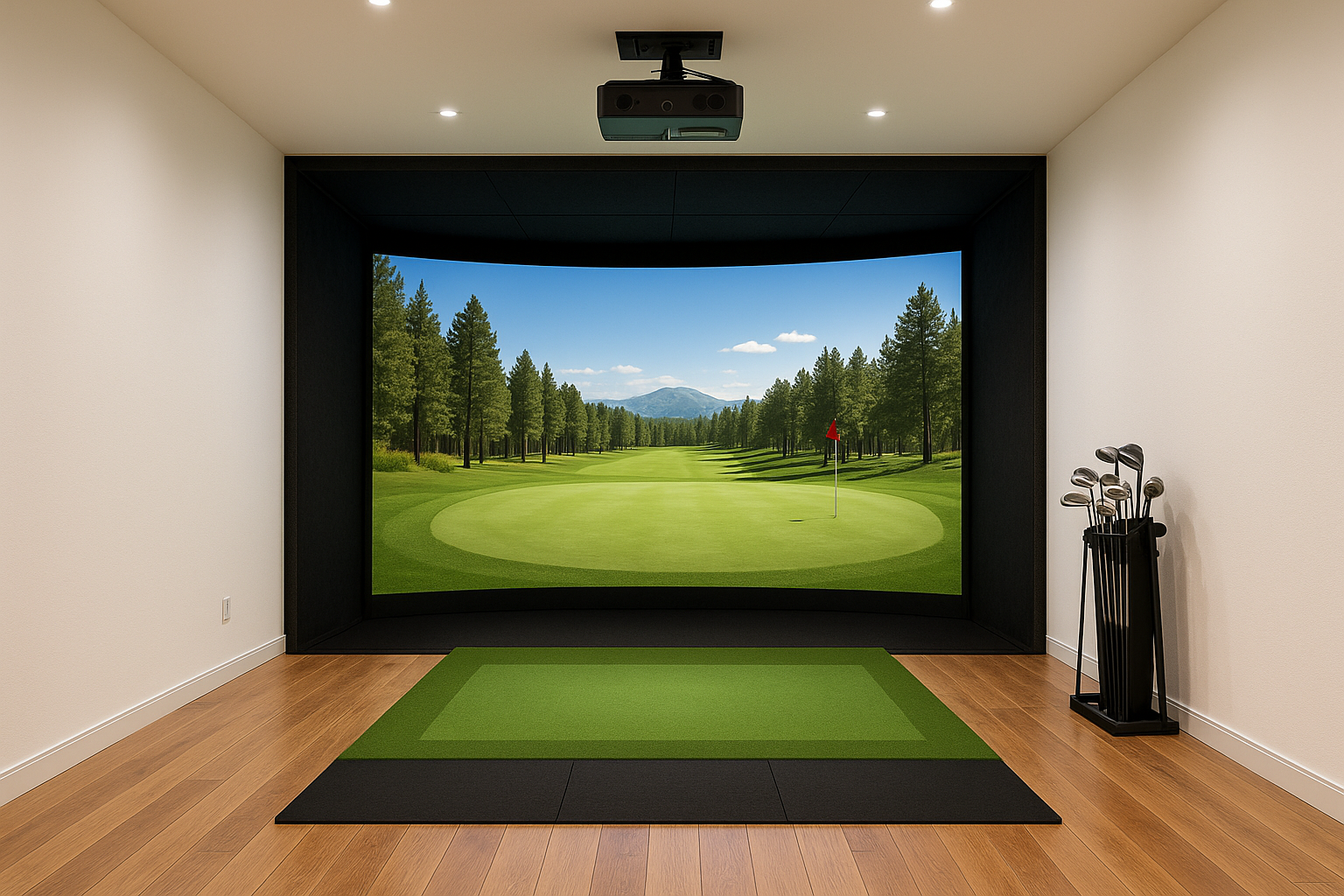
Golf Simulator Guide 2025: Costs, Pros & Cons, and How They Work
Introduction: Why Golf Simulators Are Changing the Game
Golf has always been at the mercy of weather, daylight, and available time. Rain, cold winters, or long commutes to the course often disrupt even the most dedicated players’ practice routines. For decades, golfers relied on simple putting mats or indoor swing drills to get through the offseason.
That’s all changed with golf simulators. Once reserved for elite training centers and touring professionals, these systems are now increasingly accessible to everyday golfers. From garage setups to luxury basement studios, simulators are bringing the game indoors—offering practice, entertainment, and even coaching opportunities year-round.
But what exactly is a golf simulator? How does it work? What are the true pros and cons? And how much does it cost to create your own setup at home? This guide walks you through everything you need to know.
What Is a Golf Simulator?
A golf simulator replicates the experience of playing golf indoors. You swing on a hitting mat and launch the ball into an impact screen, while advanced sensors measure the details of your swing and ball flight. The software then projects your shot on a virtual driving range or world-class course.
Most systems combine five key elements: a launch monitor (the brain of the setup), an impact screen and projector, an enclosure for safety and immersion, a hitting mat that feels like turf, and software that brings it all to life.
Entry-level setups may be as simple as a portable launch monitor paired with a net. High-end systems like FullSwing or Flightscope X3C can measure over twenty swing metrics with remarkable accuracy.
How Do Golf Simulators Work?
The moment you strike a ball, the launch monitor captures data such as speed, spin, and launch angle. That information is processed by the simulator software, which instantly calculates the ball’s trajectory and displays the shot.
Radar-based simulators—like the FlightScope Mevo+—use Doppler radar to track the ball through space. They are ideal for both indoor and outdoor play but require more ball flight distance.
Camera-based simulators, such as FullSwing and Garmin R10, use high-speed cameras to capture images at impact. These are particularly effective indoors because they need less space and are excellent at short-game data capture.
The realism is impressive. Most high-end simulators are accurate within a few yards of real-world performance. They measure everything from carry distance to face angle, often delivering over twenty different metrics per swing.
Learn more about the technology behind simulators in Golf Digest’s explainer.
Why Golfers Use Simulators
Golfers turn to simulators for three main reasons: convenience, improvement, and entertainment.
With a simulator, you can practice anytime—regardless of weather or season. This is especially valuable for players in colder climates where golf is seasonal.
For improvement, simulators provide detailed swing data that you simply can’t get at a driving range. Knowing your spin rates, launch conditions, and dispersion patterns helps you refine your technique and track progress.
And then there’s the entertainment factor. Simulators let you play bucket-list courses like Pebble Beach or St. Andrews without leaving home. Many systems also include mini-games, multiplayer modes, and online competitions that make practice fun for friends and family.
The Pros of Using a Golf Simulator
The biggest advantage is year-round access. No matter the weather, you can practice or play whenever your schedule allows.
Another benefit is the data-driven improvement. Launch monitors give instant feedback on every shot, from ball speed to club path. This accelerates learning far faster than relying on feel alone.
Simulators also bring a strong entertainment element. Imagine hosting friends for a round at Augusta National or playing a family tournament on a Saturday night.
And while the upfront costs can be high, the long-term savings are significant. Regular golfers spend thousands annually on range balls, green fees, and travel. Over time, a simulator can pay for itself.
The Cons of Using a Golf Simulator
Despite their appeal, simulators come with challenges.
The most obvious is cost. Even budget systems can run into several thousand dollars once you add a projector, screen, and mat. High-end simulators can exceed $30,000.
Space is another limitation. Most setups require at least nine feet of ceiling clearance, 15–20 feet of depth, and 10–12 feet of width. Not every home has a room that works.
Short game realism is still lacking. While full swings are impressively accurate, putting and chipping don’t always replicate real conditions.
Finally, ongoing subscriptions and maintenance add to the investment. Software updates, projector bulbs, and mat replacements are recurring costs.
How Much Does a Golf Simulator Cost?
The price depends on your budget and expectations.
Entry-level setups cost between $500 and $3,000. These typically include a portable launch monitor like Garmin R10 or Rapsodo MLM2PRO paired with a net. They’re affordable and portable but less immersive.
Mid-range systems fall between $3,000 and $10,000. Popular options like SkyTrak+ or FlightScope Mevo+ paired with enclosures and software provide excellent accuracy and balance for serious golfers.
High-end simulators range from $10,000 to over $30,000. Trackman, Foresight GCQuad, and Full Swing Golf are the gold standard, offering unmatched precision, lifelike graphics, and commercial durability.
Beyond the system, budget for setup costs: projectors ($500–$3,000), screens and enclosures ($500–$5,000), hitting mats ($300–$2,000), and software subscriptions ($200–$1,000/year).
For a detailed breakdown, see this detailed guide to simulator costs.
Popular Simulator Comparisons
SkyTrak+
SkyTrak+ is one of the most popular mid-range systems. It offers excellent accuracy, integrates with top software platforms, and is ideal for home users with limited space.
FlightScope Mevo+
The Mevo+ is versatile, offering both indoor and outdoor use. It uses radar-based tracking and provides excellent value at its price point, especially for golfers who want portability.
Trackman
Trackman is the industry leader for professionals. Known for unmatched accuracy, it measures club and ball data with extreme precision. It’s used by PGA Tour players and teaching pros worldwide, though its price tag is well into five figures.
Is a Golf Simulator Worth It?
The value of a simulator depends on how you’ll use it.
Casual golfers who want fun and occasional practice may find an entry-level or mid-range setup more than sufficient. Avid golfers who practice regularly can justify the expense of a higher-end system because of the data-driven improvement.
For coaches and commercial operators, simulators are business tools. Lessons, memberships, and rentals can generate significant revenue, making the investment well worth it.
Ultimately, it comes down to frequency of use. If you’ll practice consistently, the benefits easily outweigh the costs.
FAQ: Golf Simulators Answered
How much space do you need for a golf simulator?
Most setups require at least 9 feet of ceiling height, 15–20 feet of depth, and 10–12 feet of width. Always measure your space before buying.
Are golf simulators accurate?
Yes. High-end systems like Trackman and GCQuad are accurate within a yard or two of real-world performance. Mid-range options like SkyTrak+ and Mevo+ are slightly less precise but still excellent for practice.
Can you use real golf balls with a simulator?
Most simulators are designed for real balls, though some users opt for foam or soft balls in limited spaces. Always check manufacturer recommendations.
Do simulators help improve your game?
Absolutely. By providing feedback on ball flight, club path, and swing metrics, simulators help golfers identify weaknesses and make measurable improvements.
Can I build a DIY simulator setup?
Yes. Many golfers save money by pairing a portable launch monitor with a DIY impact screen and mat. While less polished than turnkey packages, DIY setups can be highly effective.
Final Thoughts: A New Era of Golf at Home
Golf simulators are redefining the sport. They offer year-round access, data-driven practice, and exciting entertainment experiences that extend beyond the course. While the cost and space requirements are real hurdles, the benefits often outweigh the drawbacks for serious golfers.
Whether you’re aiming to lower your handicap, entertain family and friends, or create a training business, a golf simulator can be one of the most rewarding investments you’ll ever make.
Ready to explore your options? Check out some of our Simulator and Launch Monitor setups and options. Give us a call at (855) 758-0592 or email at support@betterbirdiesgolf.com for any questions or concerns.


Leave a comment